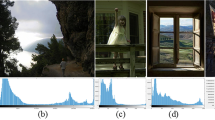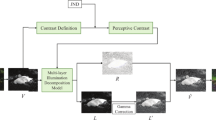Abstract
We study the problem of low lighting image enhancement. Previous enhancement methods for images under low lighting conditions usually fail to consider the factor of image degradation during image formation. As a result, the lost contrast could not be recovered after enhancement. This paper will adaptively recover the contrast and adjust the exposure for low lighting images. Our first contribution is the modeling of image degradation in low lighting conditions. Then, the local maximum color value prior is proposed, i.e., in most regions of well exposed images, the local maximum color value of a pixel will be very high. By combining the image degradation model and local maximum color value prior, we propose to recover the un-degraded images under low lighting conditions. Last, an adaptive exposure adjustment module is proposed to obtain the final result. We show that our approach enables better enhancement comparing with popular image editing tools and academic algorithms.
Similar content being viewed by others
References
Blanco M, Jonathan H M, Dingus T A. Evaluating new technologies to enhance night vision by looking at detection and recognition distances of non–motorists and objects. In Proceedings of Human Factors and Ergonomics Society, 2001, 1612–1616
Tsimhoni O, Bargman J, Minoda T, Flannagan M J. Pedestrian Detection with Near and Far Infrared Night Vision Enhancement. Technical Report, University of Michigan, Transportation Research Institute, 2004, 113–128
Tao L, Ngo H, Zhang M, Livingston A, Asari V. A multi–sensor image fusion and enhancement system for assisting drivers in poor lighting conditions. In: Proceedings of IEEE Conference on Applied Imagery and Pattern Recognition Workshop, 2005, 106–113
Ngo H, Tao L, Zhang M, Livingston A, Asari V. A visibility improvement system for low vision drivers by nonlinear enhancement of fused visible and infrared video. In: Proceedings of IEEE Conference on Computer Vision and Pattern Recognition, 2005, 25–32
Bennett E P, Mason J L, McMillan L. Multispectral bilateral video fusion. IEEE Transactions on Image Processing, 2007, 16(5): 1185–1194
Malm H, Oskarsson M, Warrant E, Clarberg P, Hasselgren J, Lejdfors C. Adaptive enhancement and noise reduction in very low light–level video. In: Proceedings of IEEE International Conference on Computer Vision, 2007, 1–8
Bennett E P, Mcmillan L. Video enhancement using per–pixel virtual exposures. In: Proceedings of ACM SIGGRAPH 2005 Papers. 2005, 845–852
Dong X, Pang Y, Wen J. Fast efficient algorithm for enhancement of low lighting video. In: Proceedings of ACM SIGGRAPH Poster. 2010
Dong X, Wang G, Pang Y, Li W, Wen J. Fast efficient algorithm for enhancement of low lighting video. In: Proceedings of IEEE International Conference on Multimedia and Expo. 2011, 1–6
Zhang X, Shen P, Luo L, Zhang L, Song J. Enhancement and noise reduction of very low light level images. In: Proceedings of IEEE International Conference on Pattern Recognition. 2012, 2034–2037
Koschmieder H. Theorie der horizontalen sichtweite. Beitr. Phys. Freien Atm., 1924, 12: 171–181
Krishnan D, Fergus R. Dark flash photography. In: Proceedings of 2009 ACM SIGGRAPH Transactions on Graphics. 2009, 1–11
Agrawal A, Raskar R, Nayar S, Li Y. Removing photography artifacts using gradient projection and flash–exposure sampling. ACM Transactions on Graphics, 2005, 24: 828–835
Eisemann E, Durand F. Flash photography enhancement via intrinsic relighting. ACM Transactions on Graphics, 2004, 23: 673–678
Fattal R. Single image dehazing. In: Proceedings of the 2008 ACM SIGGRAPH Conference. 2008, 1–9
He K, Sun J, Tang X. Single image haze removal using dark channel prior. In: Proceedings of IEEE Conference on Computer Vision and Pattern Recognition. 2009, 1956–1963
Gibson K, Vo D, Nguyen T. An investigation in dehazing compressed images and video. In: Proceedings of IEEE OCEANS. 2010, 1–8
Tarel J, Hautiere N. Fast visibility restoration from a single color or gray level image. In: Proceedings of IEEE International Conference on Computer Vision. 2009, 2201–2208
Xie B, Guo F, Cai Z. Universal strategy for surveillance video defogging. Optical Engineering, 2012, 51(10): 1–7
He K, Sun J, Tang X. Guided image filtering. Lecture Notes in Computer Science, 2010, 6311: 1–14
Mertens T, Kautz J, Reeth F. V. Exposure fusion. In: Proceedings of the 15th Pacific Conference on Computer Graphics and Applications. 2007, 382–390
Gelfand N, Adams A, Park S. H, Pulli K. Multi–exposure imaging on mobile devices. In: Proceedings of the 18th International Conference on Multimedia. 2010, 1–4
Buades A, Coll B, Morel J M. A review of image denoising algorithms, with a new one. Multiscale Modeling Simulation, 2005, 4, 490–530
Dabov K, Foi A, Katkovnik V, Egiazarian K. Image denoising by sparse 3D transformdomain collaborative filtering. IEEE Transactions on Image Processing, 2007, 16(8): 2080–2095
Author information
Authors and Affiliations
Corresponding author
Additional information
Xuan Dong received his BS in computer science and technology from Beihang University, Beijing, China in 2010. He is a PhD candidate in the Department of Computer Science and Technology, Tsinghua University, China. His current research interests include computational photography, video processing, video coding, and image segmentation.
Jiangtao Wen received his BS, MS, and PhD all in electrical engineering from Tsinghua University, Beijing, China in 1992, 1994, and 1996, respectively. From 1996 to 1998, he was a staff research fellow at the University of California, Los Angeles (UCLA). After UCLA, he served as the principal scientist at PacketVideo, chief technical officer at Morphbius Technology Inc., director of Video Codec Technologies at Mobilygen Corporation, and as a Technology Advisor at Ortiva Wireless and Stretch, Inc. Since 2009, he has been a Professor in the Department of Computer Science and Technology, Tsinghua University, China. His research focuses on multimedia communication over challenging networks and computational photography.
Rights and permissions
About this article
Cite this article
Dong, X., Wen, J. Low lighting image enhancement using local maximum color value prior. Front. Comput. Sci. 10, 147–156 (2016). https://doi.org/10.1007/s11704-015-4353-1
Received:
Accepted:
Published:
Issue Date:
DOI: https://doi.org/10.1007/s11704-015-4353-1




